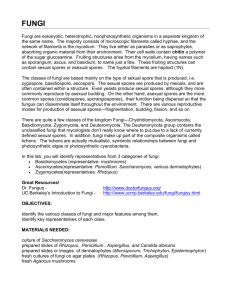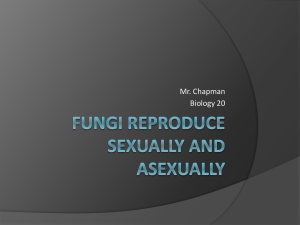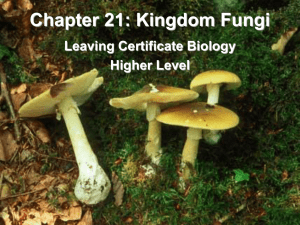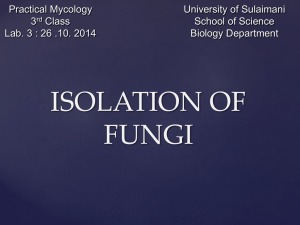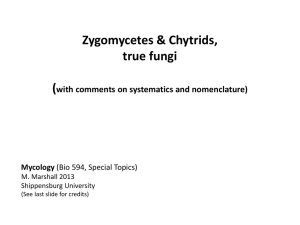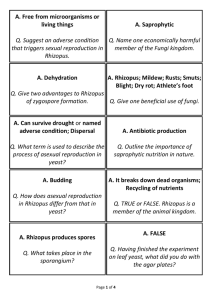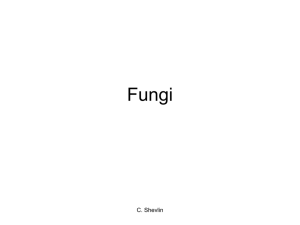Kingdom Fungi - Science M. Cunningham
advertisement
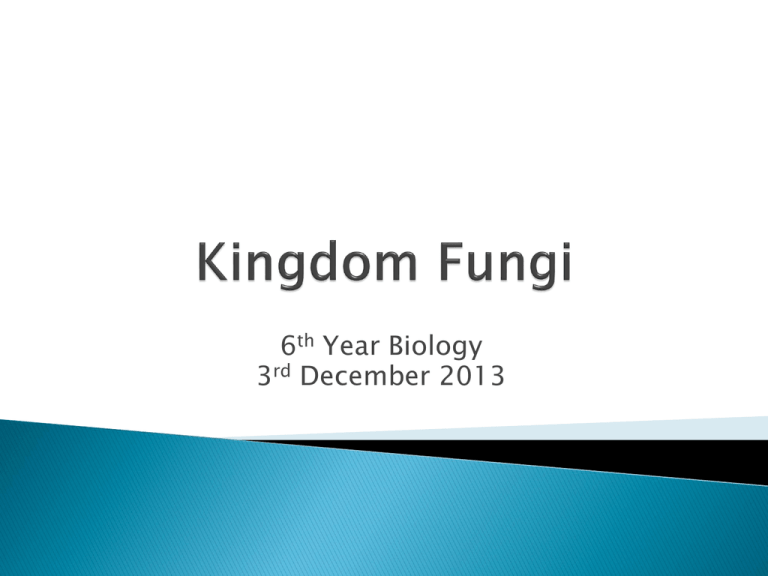
6th Year Biology 3rd December 2013 Recall that Fungi are …………. Organisms and therefore contain a …………. Recall that Fungi reproduce by means of spores Explain why Fungi are Heterotrophic organisms only Draw the structure of Rhizopus the common bread mould labelling all key structures What do you think of when you think of Fungi?? Can you name any Fungi? Where are Fungi used in Industry? What characteristics do you associate with Fungi? Fungi are Eukaryotic organisms meaning they contain a nucleus & cell organelles. They can be unicellular (yeast) or can be multicellular (Rhizopus). Fungi do not contain chloroplasts, what does this tell us about the type of Nutrition that must exist in all Fungi? Work with your partner to come up with an answer-2 minutes. All Fungi are Heterotrophic organisms meaning they cannot make their own food but instead use food made by other organisms. Just as in the Kingdom Monera. Heterotrophic Fungi can be divided into Parasitic and Saprophytic. Saprophytes: Most fungi are saprophytes. They feed on dead and decaying organic matter i.e. dead leaves and also dead animals. As the material is digested minerals are released and recycled → Saprophytic fungi are vital in the environment Parasitic fungi mostly take their food from living plants. Some fungal parasites live on animals i.e. athletes foot & ring worm. Edible Fungi include the common field mushroom which grows above ground. Another example of an edible fungi is the Truffle which grows below ground The most common poisonous mushroom are the death cap and the destroying angel. These fungi damage the cells in the lining of the intestine and liver. Liver failure is the usual cause of death. http://www.youtube.com/watch?v=QNgY0d_ ev9w Fungi reproduce by means of Spores. They lack chlorophyll and are therefore always Heterotrophic They do not ingest food, but secrete enzymes onto the food and absorb the digested molecules. They have cell walls, usually made of chitin The common bread mould is a saprophyte of starchy foods such as bread The fungus secretes enzymes into the starchy substrate. Digestion takes place outside the fungus and the digested nutrients are then absorbed by the Fungus. Draw out the structure of the Rhizopus X3 labelling all key structures. Learning homework, learn the function of each key structure of the Rhizopus 6th Year Biology 10th December 2013 Draw the structure of Rhizopus labelling all key structures and be able to explain their function. Recall what is meant by the term Sporulation and explain it’s importance in Fungi. Outline the 5 steps involved in the asexual reproduction in Rhizopus Outline the first 4 steps involved in sexual reproduction in Rhizopus Fungal digestion takes place externally, work together with your partner to come up with an explanation for this statement using Rhizopus the common bread mould as an example- 2 minutes. Rhizoid: Anchors rhizopus and allows nutrition. Sporangium: Produces and stores spores for asexual reproduction. Stolon/Hypha: Growth Sporangiophore: Reproduction Difference between hypha and mycelium: A hypha is a filament whereas a mycelium is a mass of hyphae. The development of Spores is necessary for both asexual and sexual reproduction in Fungi. Sporulation is the process of making spores. If Rhizopus can reproduce asexually what type of cell division must be used in asexual reproduction- work with your partner to come up with an answer and explianation2minutes. 1. 2. 3. 4. 5. Sporangiophores grow upwards The sporangium is formed Spores are produced by Mitosis The sporoangium dries up and splits up Spores are released and will germinate in favourable conditions to produce hypha. Rhizopus exists in two separate strains called plus and minus strains. Both strains look identical but sexual reproduction can only occur between a plus and minus strain. Zygospore nuceli divide by meiosis to form haploid nuclei Hypha grow The sporangium produces spores These are released and the spores germinate 1. 2. 3. 4. 5. The positive and minus strains of hyphae align side by side A bulge appears in both strains opposite one another forming a Progametangium They form a Gametanguim (functionproduces gametes in sexual reproduction) They unit to form a Zygospore (withstands unsuitable conditions for surival in sexual reproduction). The Zygospore germinates and the sporangium forms with spores Yeast differ to Rhizopus in that it is unicellular and it does not have a Mycelium. This is an asexual process called Budding
